Economics of Oil: Analyzing Global Demand, Supply, and Market Impact
VerifiedAdded on 2023/06/13
|5
|833
|354
Essay
AI Summary
This essay explores the economic factors influencing oil prices in the international market, focusing on the interplay between supply and demand. It highlights how reduced oil supply from the U.S. and Middle Eastern countries, coupled with increased demand from Asian nations like China and India, have driven prices upward. The analysis incorporates microeconomic principles, illustrating shifts in demand and supply curves to explain price changes. The essay also identifies the oil market as perfectly competitive, where individual countries act as price takers. The conclusion reinforces the significant impact of supply shortages and demand increases on oil prices, emphasizing the competitive nature of the market.
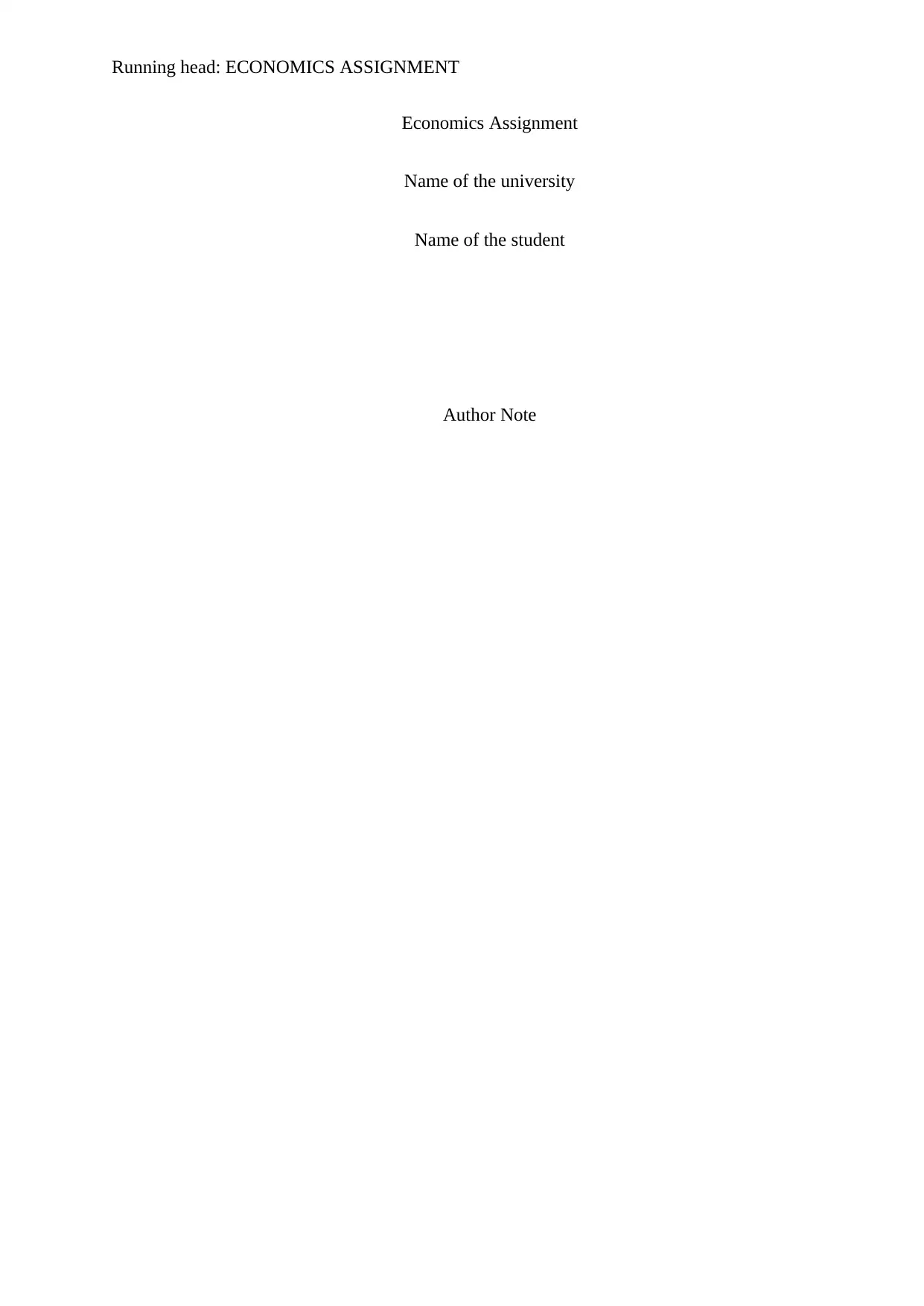
Running head: ECONOMICS ASSIGNMENT
Economics Assignment
Name of the university
Name of the student
Author Note
Economics Assignment
Name of the university
Name of the student
Author Note
Paraphrase This Document
Need a fresh take? Get an instant paraphrase of this document with our AI Paraphraser
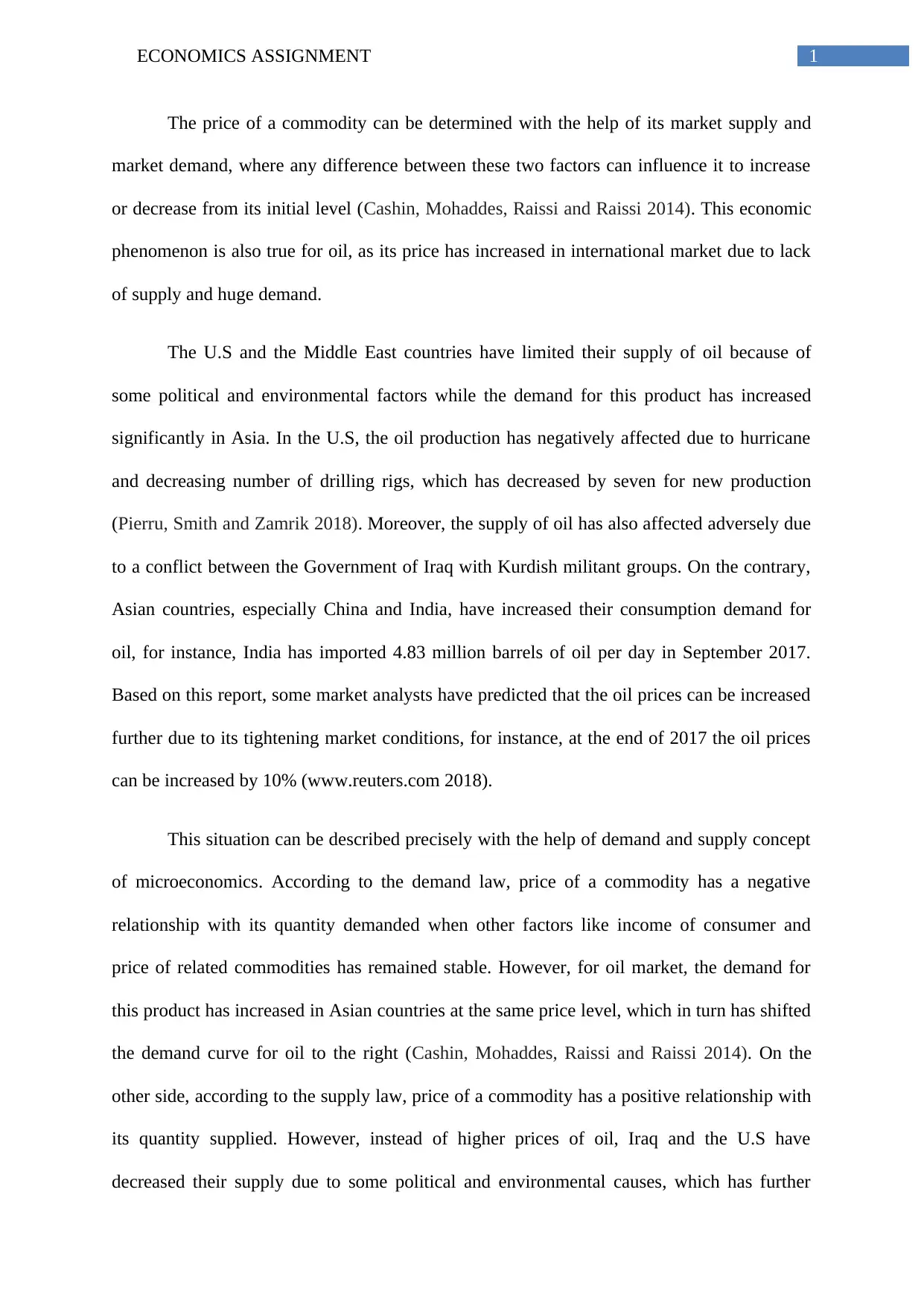
1ECONOMICS ASSIGNMENT
The price of a commodity can be determined with the help of its market supply and
market demand, where any difference between these two factors can influence it to increase
or decrease from its initial level (Cashin, Mohaddes, Raissi and Raissi 2014). This economic
phenomenon is also true for oil, as its price has increased in international market due to lack
of supply and huge demand.
The U.S and the Middle East countries have limited their supply of oil because of
some political and environmental factors while the demand for this product has increased
significantly in Asia. In the U.S, the oil production has negatively affected due to hurricane
and decreasing number of drilling rigs, which has decreased by seven for new production
(Pierru, Smith and Zamrik 2018). Moreover, the supply of oil has also affected adversely due
to a conflict between the Government of Iraq with Kurdish militant groups. On the contrary,
Asian countries, especially China and India, have increased their consumption demand for
oil, for instance, India has imported 4.83 million barrels of oil per day in September 2017.
Based on this report, some market analysts have predicted that the oil prices can be increased
further due to its tightening market conditions, for instance, at the end of 2017 the oil prices
can be increased by 10% (www.reuters.com 2018).
This situation can be described precisely with the help of demand and supply concept
of microeconomics. According to the demand law, price of a commodity has a negative
relationship with its quantity demanded when other factors like income of consumer and
price of related commodities has remained stable. However, for oil market, the demand for
this product has increased in Asian countries at the same price level, which in turn has shifted
the demand curve for oil to the right (Cashin, Mohaddes, Raissi and Raissi 2014). On the
other side, according to the supply law, price of a commodity has a positive relationship with
its quantity supplied. However, instead of higher prices of oil, Iraq and the U.S have
decreased their supply due to some political and environmental causes, which has further
The price of a commodity can be determined with the help of its market supply and
market demand, where any difference between these two factors can influence it to increase
or decrease from its initial level (Cashin, Mohaddes, Raissi and Raissi 2014). This economic
phenomenon is also true for oil, as its price has increased in international market due to lack
of supply and huge demand.
The U.S and the Middle East countries have limited their supply of oil because of
some political and environmental factors while the demand for this product has increased
significantly in Asia. In the U.S, the oil production has negatively affected due to hurricane
and decreasing number of drilling rigs, which has decreased by seven for new production
(Pierru, Smith and Zamrik 2018). Moreover, the supply of oil has also affected adversely due
to a conflict between the Government of Iraq with Kurdish militant groups. On the contrary,
Asian countries, especially China and India, have increased their consumption demand for
oil, for instance, India has imported 4.83 million barrels of oil per day in September 2017.
Based on this report, some market analysts have predicted that the oil prices can be increased
further due to its tightening market conditions, for instance, at the end of 2017 the oil prices
can be increased by 10% (www.reuters.com 2018).
This situation can be described precisely with the help of demand and supply concept
of microeconomics. According to the demand law, price of a commodity has a negative
relationship with its quantity demanded when other factors like income of consumer and
price of related commodities has remained stable. However, for oil market, the demand for
this product has increased in Asian countries at the same price level, which in turn has shifted
the demand curve for oil to the right (Cashin, Mohaddes, Raissi and Raissi 2014). On the
other side, according to the supply law, price of a commodity has a positive relationship with
its quantity supplied. However, instead of higher prices of oil, Iraq and the U.S have
decreased their supply due to some political and environmental causes, which has further
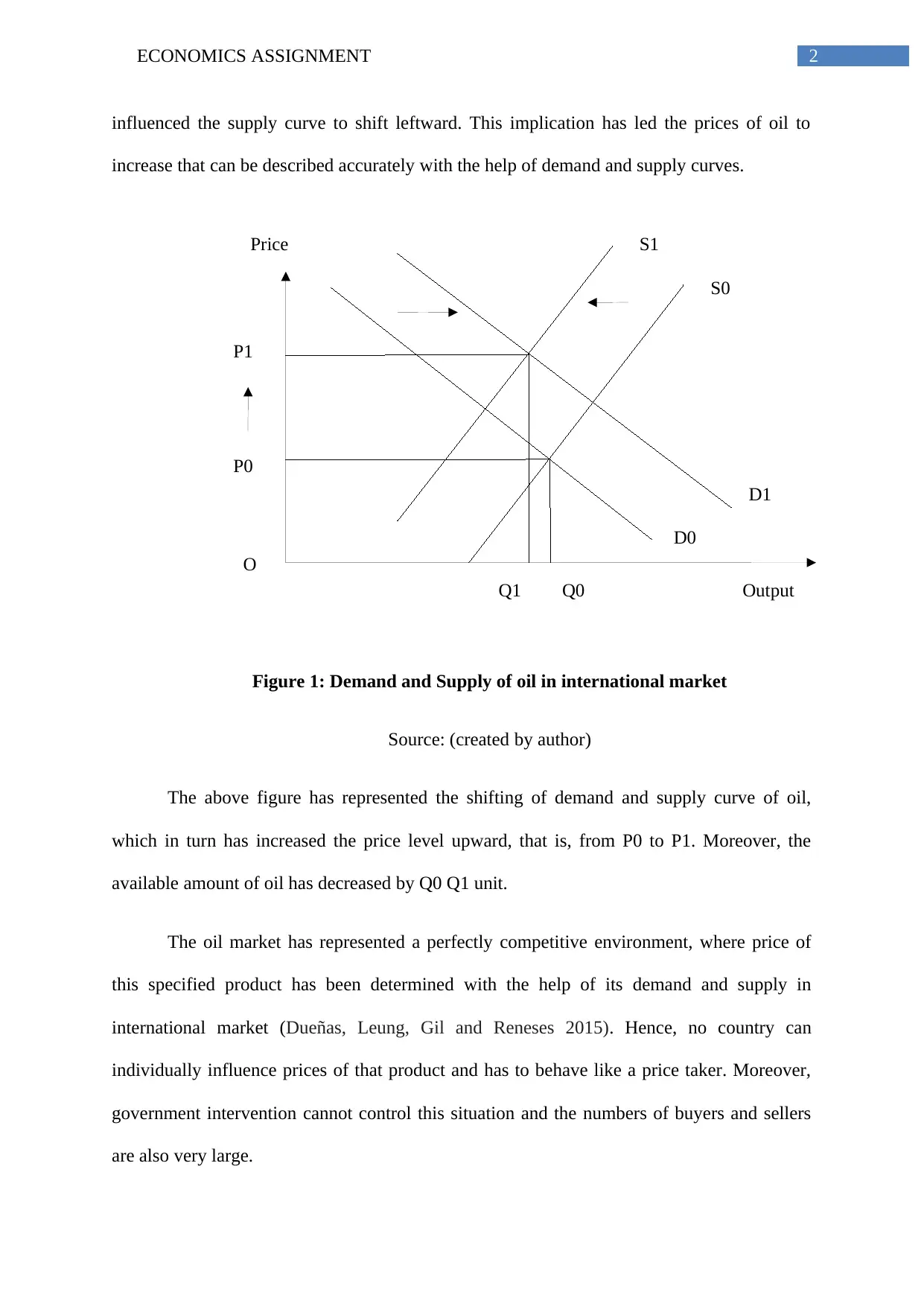
2ECONOMICS ASSIGNMENT
P0
P1
Price
Output
S0
S1
D0
D1
O
Q0Q1
influenced the supply curve to shift leftward. This implication has led the prices of oil to
increase that can be described accurately with the help of demand and supply curves.
Figure 1: Demand and Supply of oil in international market
Source: (created by author)
The above figure has represented the shifting of demand and supply curve of oil,
which in turn has increased the price level upward, that is, from P0 to P1. Moreover, the
available amount of oil has decreased by Q0 Q1 unit.
The oil market has represented a perfectly competitive environment, where price of
this specified product has been determined with the help of its demand and supply in
international market (Dueñas, Leung, Gil and Reneses 2015). Hence, no country can
individually influence prices of that product and has to behave like a price taker. Moreover,
government intervention cannot control this situation and the numbers of buyers and sellers
are also very large.
P0
P1
Price
Output
S0
S1
D0
D1
O
Q0Q1
influenced the supply curve to shift leftward. This implication has led the prices of oil to
increase that can be described accurately with the help of demand and supply curves.
Figure 1: Demand and Supply of oil in international market
Source: (created by author)
The above figure has represented the shifting of demand and supply curve of oil,
which in turn has increased the price level upward, that is, from P0 to P1. Moreover, the
available amount of oil has decreased by Q0 Q1 unit.
The oil market has represented a perfectly competitive environment, where price of
this specified product has been determined with the help of its demand and supply in
international market (Dueñas, Leung, Gil and Reneses 2015). Hence, no country can
individually influence prices of that product and has to behave like a price taker. Moreover,
government intervention cannot control this situation and the numbers of buyers and sellers
are also very large.
⊘ This is a preview!⊘
Do you want full access?
Subscribe today to unlock all pages.

Trusted by 1+ million students worldwide
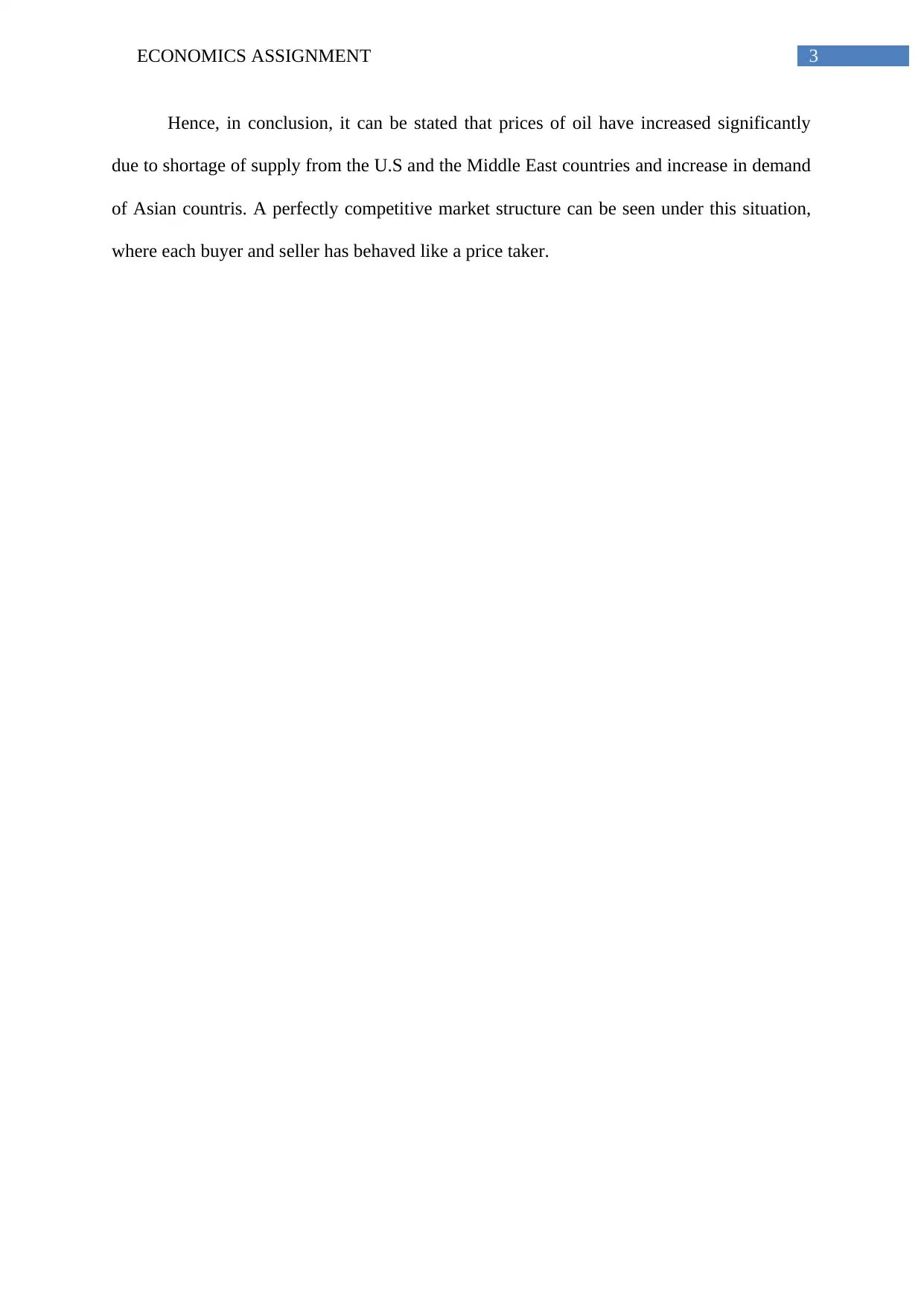
3ECONOMICS ASSIGNMENT
Hence, in conclusion, it can be stated that prices of oil have increased significantly
due to shortage of supply from the U.S and the Middle East countries and increase in demand
of Asian countris. A perfectly competitive market structure can be seen under this situation,
where each buyer and seller has behaved like a price taker.
Hence, in conclusion, it can be stated that prices of oil have increased significantly
due to shortage of supply from the U.S and the Middle East countries and increase in demand
of Asian countris. A perfectly competitive market structure can be seen under this situation,
where each buyer and seller has behaved like a price taker.
Paraphrase This Document
Need a fresh take? Get an instant paraphrase of this document with our AI Paraphraser
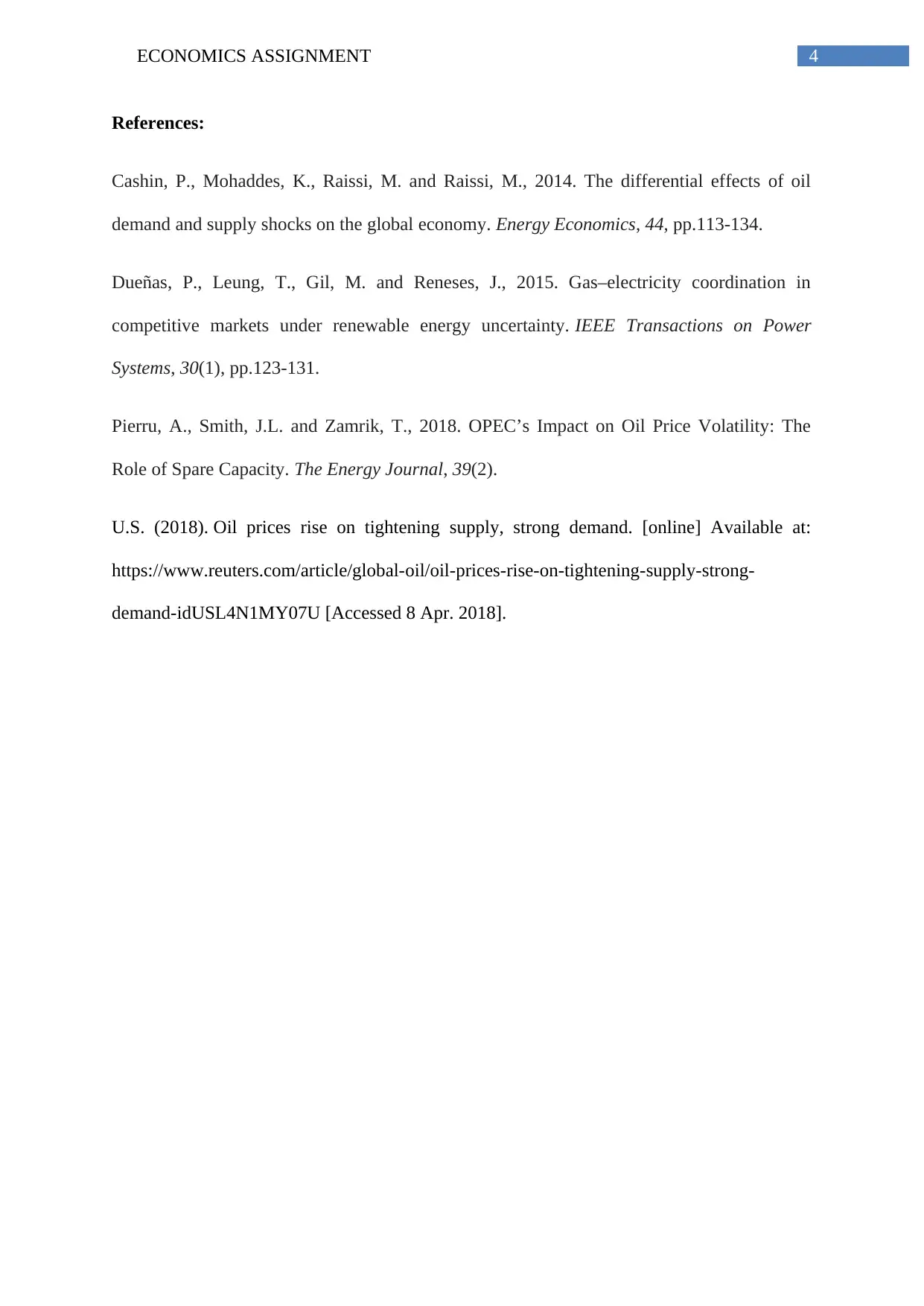
4ECONOMICS ASSIGNMENT
References:
Cashin, P., Mohaddes, K., Raissi, M. and Raissi, M., 2014. The differential effects of oil
demand and supply shocks on the global economy. Energy Economics, 44, pp.113-134.
Dueñas, P., Leung, T., Gil, M. and Reneses, J., 2015. Gas–electricity coordination in
competitive markets under renewable energy uncertainty. IEEE Transactions on Power
Systems, 30(1), pp.123-131.
Pierru, A., Smith, J.L. and Zamrik, T., 2018. OPEC’s Impact on Oil Price Volatility: The
Role of Spare Capacity. The Energy Journal, 39(2).
U.S. (2018). Oil prices rise on tightening supply, strong demand. [online] Available at:
https://www.reuters.com/article/global-oil/oil-prices-rise-on-tightening-supply-strong-
demand-idUSL4N1MY07U [Accessed 8 Apr. 2018].
References:
Cashin, P., Mohaddes, K., Raissi, M. and Raissi, M., 2014. The differential effects of oil
demand and supply shocks on the global economy. Energy Economics, 44, pp.113-134.
Dueñas, P., Leung, T., Gil, M. and Reneses, J., 2015. Gas–electricity coordination in
competitive markets under renewable energy uncertainty. IEEE Transactions on Power
Systems, 30(1), pp.123-131.
Pierru, A., Smith, J.L. and Zamrik, T., 2018. OPEC’s Impact on Oil Price Volatility: The
Role of Spare Capacity. The Energy Journal, 39(2).
U.S. (2018). Oil prices rise on tightening supply, strong demand. [online] Available at:
https://www.reuters.com/article/global-oil/oil-prices-rise-on-tightening-supply-strong-
demand-idUSL4N1MY07U [Accessed 8 Apr. 2018].
1 out of 5
Related Documents
Your All-in-One AI-Powered Toolkit for Academic Success.
+13062052269
info@desklib.com
Available 24*7 on WhatsApp / Email
![[object Object]](/_next/static/media/star-bottom.7253800d.svg)
Unlock your academic potential
Copyright © 2020–2025 A2Z Services. All Rights Reserved. Developed and managed by ZUCOL.





